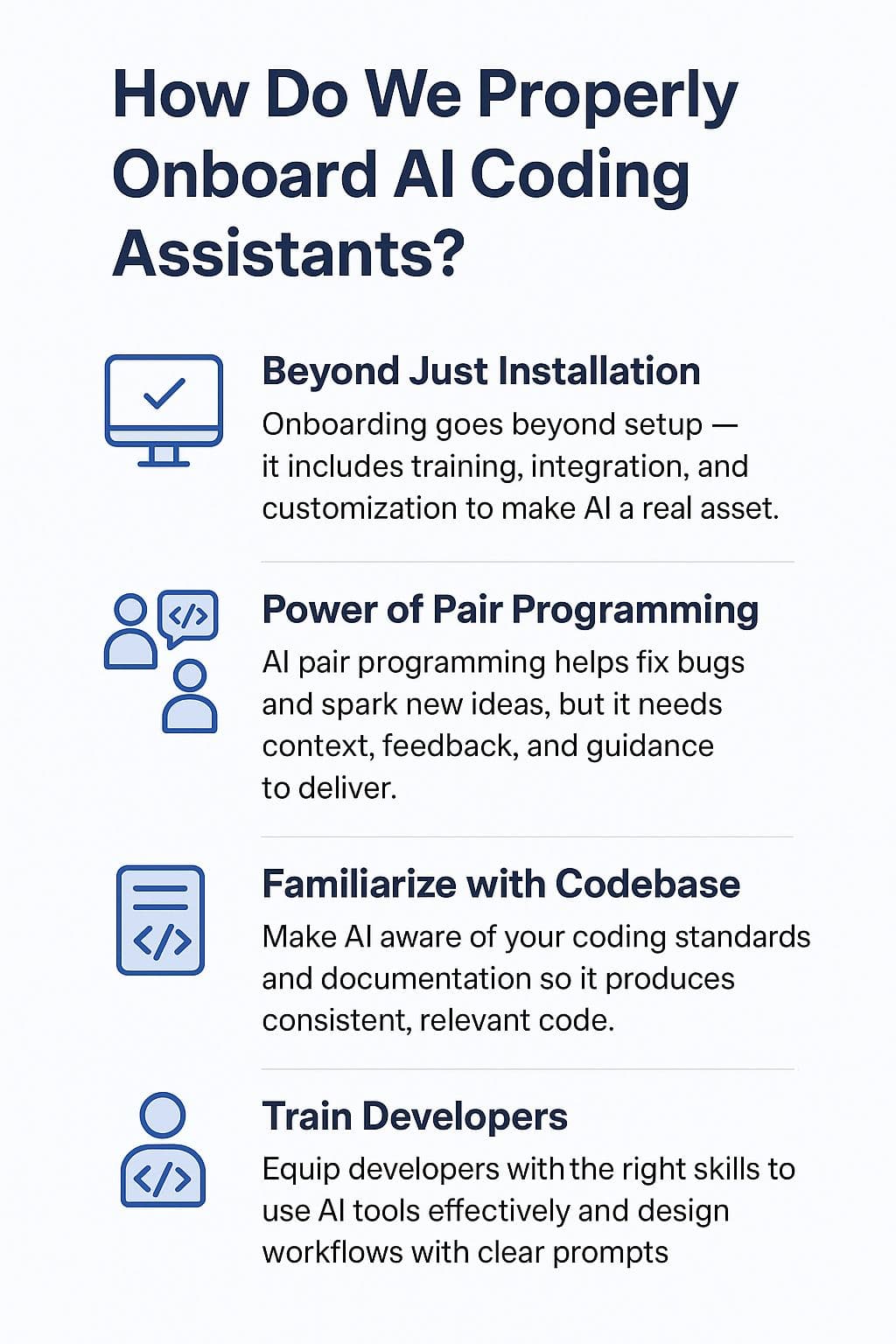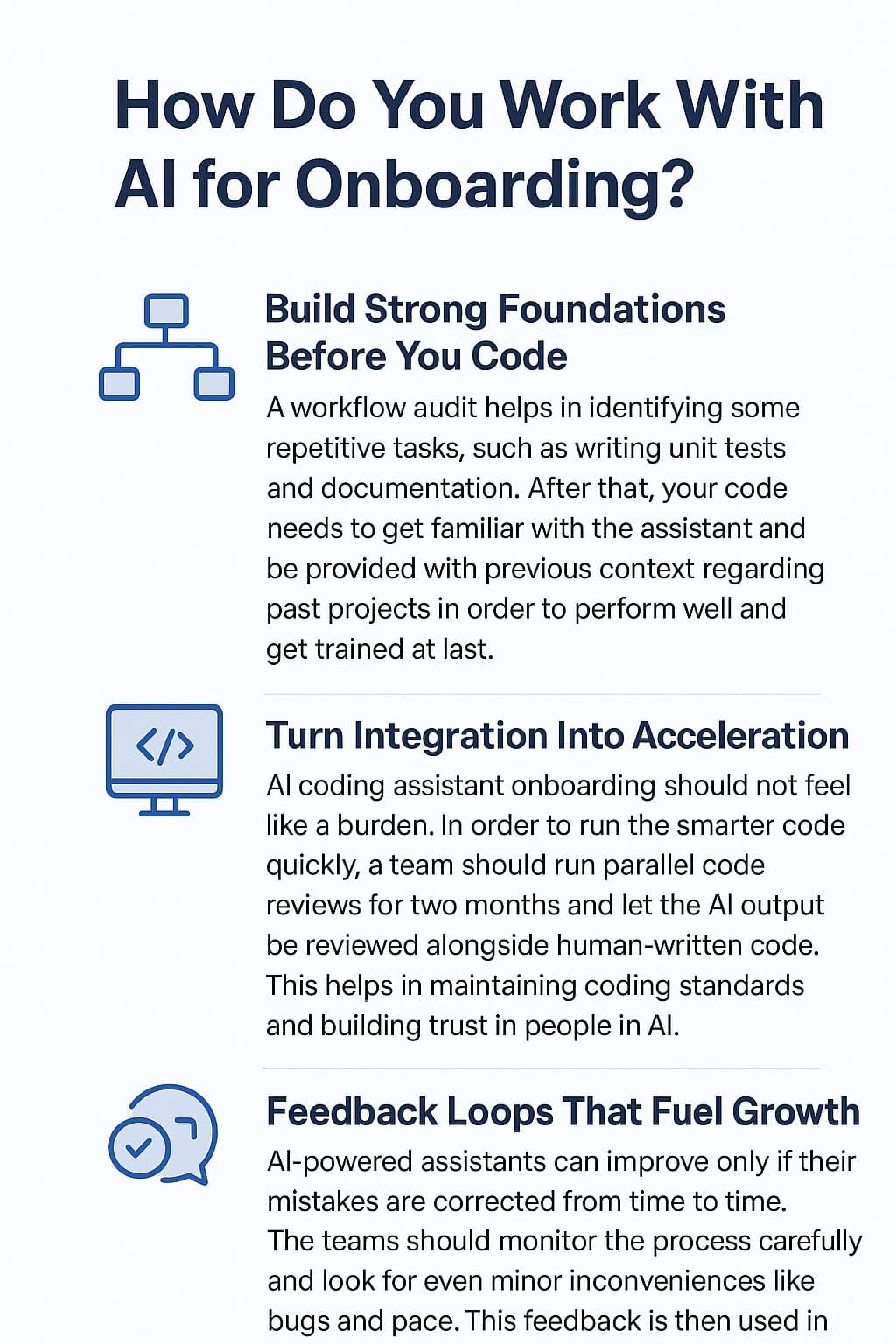AI-powered coding assistants are flooding the market with high claims and higher blame. But not everyone seems to be a happy user. These assistants are being marketed on some next level. And the result? Our Super high expectations.
They have been designed to avoid errors that crawl right through the human eye and to increase productivity, along with reducing repetitive tasks. But the main question is, do they do these tasks properly, or are the AI coding Assistants being charged with wrong accusations?
A GitHub survey reported that 97% of software engineers were found using AI coding, and still, many developers claim it is more of a distraction than a solution. They have claimed it is failing them in providing the services it ought to. But we really need to accept the harsh truth that it's actually the other way round.
This blog breaks down why AI assistants aren’t threats and how poor onboarding leads to failure. Along with it, the exact steps teams can take to finally make AI a reliable partner.
Are AI Coding Assistants Really a Threat to Developers?
If you are a tech enthusiast, you know that AI-powered assistants have been the talk of the town since their launch. But this hype has always come along with equal doubts and skepticism. Let's see where the actual problem resides and clear the myths in the air:
1. Developers as Partners
Many people claim that AI is here to create an unemployment apocalypse. They assume that it can easily take over a developer's work and throw it off the pedestal. The answer: Yes, AI can handle various repetitive tasks, but handling complex systems and carrying out deep logical thinking is not its cup of tea either.
2. Clear Prompts Matter
Our expectations from AI are nothing less than your parents from your X standard board results. We expect it to give instant results without putting any effort ourselves. That’s where AI/ML Development Services step in, which further help in clearing instructions and well-defined prompts in order to understand your context and give proper outcomes.
3. Human Checks Needed
Relying completely upon an AI system is not a smart move. Even the thought that more AI usage or integration will automatically lead to better code is a flawed idea. However, continuous and overuse of these tools without human monitoring can lead to bloated code with bugs.
4. Emotional Roadblocks
Sometimes, your AI Coding tools fail because of some emotional triggers that may affect you internally. Like, developers may feel threatened and insecure about their jobs. Similarly, delays in results may be disappointing for you. And, so is being afraid of facing any long-term issues in the future.
5. Knowledge Gaps
Your dead curiosity can surely be the reason for not being able to follow the given guidelines because you didn't care about it in the first place. For example, a team tried to run a code on GitHub Copilot but ended up abandoning it in just two weeks. Because they felt that the results were slow and the system was full of bugs. However, the real issue wasn't the Copilot; it was their inability to use the tool quickly.
How Do We Properly Onboard AI Coding Assistants?

Honestly, you can't escape the fact that mutual inclusivity is important for every technical advancement. The developers need to understand and further simplify the working of AI. However, most importantly, it is to give constant lessons on codebases to avoid errors.
Below is our guide for the complete reason of onboarding:
1. Beyond Just Installation
Onboarding doesn’t mean downloading or installing an assistant. The real onboarding includes training, integrating, and making relevant changes in the tool so that it can turn into an asset.
2. Power of Pair Programming
Pair programming helps in fixing bugs and generating new ideas. But, it is really important to guide and provide AI with organized context and prompts, and constant feedback after that. SoluteLabs provides AI Agent Development to create assistants capable of handling end-to-end processes. This works like magic in improving the performance.
3. Familiarize with Codebase
In order to generate consistent, relevant code from your AI system, you need to make it familiar with the infrastructure. This clearly means to align it following your coding standards and documentation as well.
4. Train Developers
Software developers need to get trained in using the tools in a quickly manner. These efforts can only make this collaboration justified. Even the workflow of developers should ensure clear prompts while using the tools.
Still Struggling to Make AI Coding Work in Your Team?
When you introduce a new system, you cannot just assume everyone is a master at it. That's exactly what happened when AI-powered Coding Assistants were launched by organizations. After that, developers were left to work out everything themselves. Eventually, software developers started blaming the tools for being faulty instead of refining their expertise in order to use them quickly.
Furthermore, do you think AI assistants will magically understand you? No, as without clear prompts, documentation, and context-based codebases, AI is helpless too. However, lacking integration with CI/CD workflows, the assistant is left alone, wondering about its existence, and plays no more part in being a serious part of the development. This means integration of AI into the developer workflow is not just a cakewalk; it needs serious effort.
Lastly, many teams have set up very high and unrealistic expectations for AI tools. They expect production-ready code from day one. Also, every lead assistant improves and thrives better only when they are seen as equal collaborators and not as competitors. It's really important to review and correct them with constant feedback.
How Do You Work With AI for Onboarding?

Well, adopting an AI system is never about installations; it's all about well-structured and functional onboarding conditions. And, in order to make this onboarding reliable and quick, you really need to follow the following steps by heart:
1. Build Strong Foundations Before You Code
A workflow audit helps in identifying some repetitive tasks, such as writing unit tests and documentation. After that, your code needs to get familiar with the assistant and be provided with previous context regarding past projects in order to perform well and get trained at last.
2. Turn Integration Into Acceleration
Al coding assistant onboarding should not feel like a burden. In order to run the smarter code quickly, a team should run parallel code reviews for two months and let the AI output be reviewed alongside human-written code. This helps in maintaining coding standards and building trust in people in AI.
3. Feedback Loops That Fuel Growth
AI-powered assistants can improve only if their mistakes are corrected from time to time. The teams should monitor the process carefully and look for even minor inconveniences like bugs and pace. This feedback is then used in updating prompts and upgrading the integration process easily. Furthermore, AI has evolved as a reliable partner, so alongside, we just need to put in some faith.
When these assistants are treated equally like collaborative partners, they tend to increase productivity and help the developers focus on solving higher-level problems. The only difference between frustration and transformation lies entirely in how you onboard the AI-infused infrastructure.
AI Isn’t Here to Replace You; It’s Here to Push You Forward!
One of the best examples has been set by the JavaScript team. Here, they invested time and energy in properly training themselves for onboarding. Instead of tossing the AI into the workflow blindly, they focused on prompt practice and context-sharing in the first few weeks as preferred. And the results were outstanding, AI adapted itself, and errors and inconsistencies were reduced drastically.
One more case comes from a team that is spread across various time zones. They went for a hybrid approach, which further helped them a lot. Further, their releases were faster, and it allowed them to ship updates more consistently than before. Also, AI helped in bringing synchronization in the work and was further maintained by human developers.
Both of these examples confirmed the same results of fewer bugs, faster merging, and happy faces of developers. So, No! AI is not here to replace the workforce; instead, it's here to make them move ahead faster with confidence.
Conclusion
AI coding assistants are not the problem. The reason behind, is that you created problems yourself by skipping those basic onboarding lessons. We should understand that there is a significant difference between a potential getting wasted and measurable productivity gains. The steps we mentioned, from auditing workflows to creating feedback loops, are the most crucial part of the whole setup. They are not just a want but a need of the hour.
At SoluteLabs, we don’t just help you keep up with AI-we help you lead the way. From rock-solid data foundations to reliable infrastructure, we build your AI systems from the ground up. We cater to you with advanced models, ethical practices, and continuous learning services. Hence, why settle for following the trend when you can set it?
Ready to make AI work for your team? Book a consultation today and let’s build the future together.






